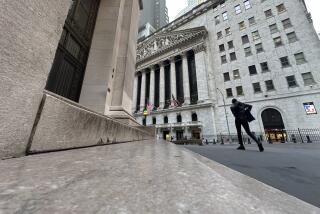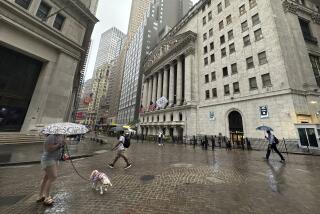Appetite for risk rises as investors’ worst fears recede
- Share via
The risk takers are back in the world’s financial markets, and they’re hungry.
U.S. stocks zoomed this week, with blue-chip indexes reaching their highest levels since at least Feb. 1.
And investors’ renewed hunt for opportunities has extended well beyond Wall Street this spring. Foreign stocks are attracting buyers again. So are corporate junk bonds and tax-free municipal bonds, which has driven down yields on those issues from their recent peaks.
What many investors don’t want are the securities they couldn’t buy fast enough through most of the winter: U.S. Treasury bonds.
It usually isn’t a good thing when interest rates are rising, but the jump in yields on Treasury issues is, in fact, an encouraging sign. What it’s telling us is that the fear level in global markets is receding.
People had been buying Treasuries because they worried that the U.S. mortgage-market debacle would lead to a meltdown of the financial system. At least with government bonds you could be assured of getting your principal back from Uncle Sam.
Now, with the end of the world forestalled for the moment, some investors are selling low-yielding Treasuries and putting the proceeds into other securities that offer more opportunity -- with more risk.
That includes Google Inc., which rocketed $89.87 on Friday, or 20%, to $539.41, after the company’s strong first-quarter earnings report Thursday reminded investors that life goes on, and so do a lot of businesses, even when financial markets are in hysterics.
In hindsight, of course, stocks were a better buy six weeks ago, when the Dow Jones industrial average was 1,100 points lower.
But if you have regrets about holding back, remember this: There was no way to know for certain that the Federal Reserve’s unprecedented moves in mid-March to lend massive sums to banks and brokerages would produce the intended effect.
The Fed had to fix an increasingly dire situation: the reluctance of banks and brokerages to lend to one another. It took the near-failure of brokerage Bear Stearns Cos. to bring the crisis to a head and to open the Fed’s lending window to every major financial institution.
That did the trick. If it hadn’t worked, however, who knows where stock prices would be today.
Investors who were playing it safe a month ago, either buying government bonds or hoarding cash in short-term accounts, were in effect buying insurance policies. As it stands now, they didn’t need that insurance. But most people don’t wish their house would burn down simply to justify the cost of the insurance premiums they’ve paid for years.
Besides, it could be that the risk takers are getting back into stocks too early.
The Fed hasn’t ended the twin crises of rising mortgage delinquencies and falling home prices. And the continuing surge in the price of oil, which reached a record $116.69 a barrel Friday, raises the prospect of more pain ahead for the economy.
“The financial markets probably have bottomed, but the real economy probably hasn’t,” said Michael Darda, chief economist at investment firm MKM Partners in Greenwich, Conn.
Given plummeting consumer and business confidence and falling employment, “If we don’t have a recession, we’re only going to avoid it by the skin of our teeth,” he said.
Risk takers, however, know from history that they aren’t supposed to wait for a recession to end before jumping back into the stock market.
“The financial markets look ahead, not back,” Darda notes.
If nothing else, the Fed bought investors some time to be more rational in deciding what to do with their money -- more rational than they could be when the financial system was in real danger of unraveling.
With that situation stabilized, “The market has a good window here for a few months,” said Bruce Bittles, chief investment strategist at brokerage Robert W. Baird & Co. in Nashville.
One element of the bullish case for equities is that the government’s tax rebates, which will land in 130 million mailboxes beginning in May, are likely to be at least some help in underpinning consumer spending.
What’s more, healthy first-quarter profit reports from some big-name companies are demonstrating the benefits of globalization, at least to the corporate bottom line. Economic growth outside the U.S. is bolstering many American companies’ earnings, just as investors hoped it would.
“I see the global economy continuing to outperform the U.S. for the next several years,” Darda said.
Stock market bulls also take comfort in what they believe are reasonable share prices relative to earnings. The market never got that expensive in the good years of 2003 to mid-’07, they say.
So with the Standard & Poor’s 500 index still down 11.2% from its record high reached in October, and earnings holding up at many companies, the argument is that the market remains a good long-term value.
Ultimately, it’s optimism about the future that drives stock prices.
“The market is all about sentiment and perception,” said Marc Pado, U.S. market strategist at brokerage Cantor Fitzgerald.
The sentiment and perception right now is that the future isn’t as scary as it appeared a month ago. Sometimes, that’s all it takes to get people interested in taking some risks again.
--
More to Read
Inside the business of entertainment
The Wide Shot brings you news, analysis and insights on everything from streaming wars to production — and what it all means for the future.
You may occasionally receive promotional content from the Los Angeles Times.










